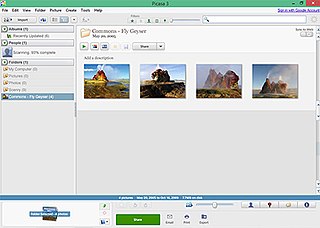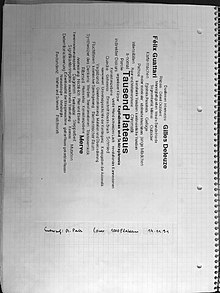Spamdexing is the deliberate manipulation of search engine indexes. It involves a number of methods, such as link building and repeating unrelated phrases, to manipulate the relevance or prominence of resources indexed in a manner inconsistent with the purpose of the indexing system.
An HTML element is a type of HTML document component, one of several types of HTML nodes. The first used version of HTML was written by Tim Berners-Lee in 1993 and there have since been many versions of HTML. The most commonly used version is HTML 4.01, which became official standard in December 1999. An HTML document is composed of a tree of simple HTML nodes, such as text nodes, and HTML elements, which add semantics and formatting to parts of document. Each element can have HTML attributes specified. Elements can also have content, including other elements and text.
An image retrieval system is a computer system used for browsing, searching and retrieving images from a large database of digital images. Most traditional and common methods of image retrieval utilize some method of adding metadata such as captioning, keywords, title or descriptions to the images so that retrieval can be performed over the annotation words. Manual image annotation is time-consuming, laborious and expensive; to address this, there has been a large amount of research done on automatic image annotation. Additionally, the increase in social web applications and the semantic web have inspired the development of several web-based image annotation tools.

Picasa was a cross-platform image organizer and image viewer for organizing and editing digital photos, integrated with a now defunct photo-sharing website, originally created by a company named Lifescape in 2002. "Picasa" is a blend of the name of Spanish painter Pablo Picasso, the word casa and "pic" for pictures.

In information systems, a tag is a keyword or term assigned to a piece of information. This kind of metadata helps describe an item and allows it to be found again by browsing or searching. Tags are generally chosen informally and personally by the item's creator or by its viewer, depending on the system, although they may also be chosen from a controlled vocabulary.
In information retrieval, tf–idf, short for term frequency–inverse document frequency, is a measure of importance of a word to a document in a collection or corpus, adjusted for the fact that some words appear more frequently in general. It was often used as a weighting factor in searches of information retrieval, text mining, and user modeling. A survey conducted in 2015 showed that 83% of text-based recommender systems in digital libraries used tf–idf.
Keyword density is the percentage of times a keyword or phrase appears on a web page compared to the total number of words on the page. In the context of search engine optimization, keyword density can be used to determine whether a web page is relevant to a specified keyword or keyword phrase.
Product finders are information systems that help consumers to identify products within a large palette of similar alternative products. Product finders differ in complexity, the more complex among them being a special case of decision support systems. Conventional decision support systems, however, aim at specialized user groups, e.g. marketing managers, whereas product finders focus on consumers.
Search engine indexing is the collecting, parsing, and storing of data to facilitate fast and accurate information retrieval. Index design incorporates interdisciplinary concepts from linguistics, cognitive psychology, mathematics, informatics, and computer science. An alternate name for the process, in the context of search engines designed to find web pages on the Internet, is web indexing.
Knowledge management software is a subset of content management software, which contains a range of software that specializes in the way information is collected, stored and/or accessed. The concept of knowledge management is based on a range of practices used by an individual, a business, or a large corporation to identify, create, represent and redistribute information for a range of purposes. Software that enables an information practice or range of practices at any part of the processes of information management can be deemed to be called information management software. A subset of information management software that emphasizes an approach to build knowledge out of information that is managed or contained is often called knowledge management software.
The Corpus of Contemporary American English (COCA) is a one-billion-word corpus of contemporary American English. It was created by Mark Davies, retired professor of corpus linguistics at Brigham Young University (BYU).
A selection-based search system is a search engine system in which the user invokes a search query using only the mouse. A selection-based search system allows the user to search the internet for more information about any keyword or phrase contained within a document or webpage in any software application on their desktop computer using the mouse.
Folksonomy is a classification system in which end users apply public tags to online items, typically to make those items easier for themselves or others to find later. Over time, this can give rise to a classification system based on those tags and how often they are applied or searched for, in contrast to a taxonomic classification designed by the owners of the content and specified when it is published. This practice is also known as collaborative tagging, social classification, social indexing, and social tagging. Folksonomy was originally "the result of personal free tagging of information [...] for one's own retrieval", but online sharing and interaction expanded it into collaborative forms. Social tagging is the application of tags in an open online environment where the tags of other users are available to others. Collaborative tagging is tagging performed by a group of users. This type of folksonomy is commonly used in cooperative and collaborative projects such as research, content repositories, and social bookmarking.
MAXQDA is a software program designed for computer-assisted qualitative and mixed methods data, text and multimedia analysis in academic, scientific, and business institutions. It is being developed and distributed by VERBI Software based in Berlin, Germany.
Patent visualisation is an application of information visualisation. The number of patents has been increasing, encouraging companies to consider intellectual property as a part of their strategy. Patent visualisation, like patent mapping, is used to quickly view a patent portfolio.
QDA Miner is mixed methods and qualitative data analysis software developed by Provalis Research. The program was designed to assist researchers in managing, coding and analyzing qualitative data.
WordStat is a content analysis and text mining software. It was first released in 1998 after being developed by Normand Peladeau from Provalis Research. The latest version 9 was released in 2021.
Social navigation is a form of social computing introduced by Paul Dourish and Matthew Chalmers in 1994, who defined it as when "movement from one item to another is provoked as an artifact of the activity of another or a group of others". According to later research in 2002, "social navigation exploits the knowledge and experience of peer users of information resources" to guide users in the information space, and that it is becoming more difficult to navigate and search efficiently with all the digital information available from the World Wide Web and other sources. Studying others' navigational trails and understanding their behavior can help improve one's own search strategy by guiding them to make more informed decisions based on the actions of others.
Interpolation sort is a kind of bucket sort. It uses an interpolation formula to assign data to the bucket. A general interpolation formula is:

















